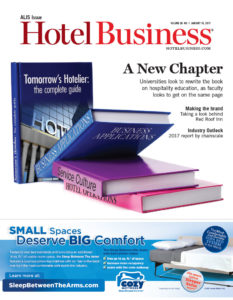Although the upper-upscale hotel segment continues to post strong operating results, it is expected to see another year of declining occupancy levels and slower rate growth in 2017. At this stage in the lodging cycle, experts see little room to drive ADRs much higher, when the hotels in question are already performing just below peak levels.
According to CBRE Hotels’ Americas Research’s year-end 2016 forecast, the segment posted an overall occupancy of 74.1%, down -0.3% from a 2015 high of 74.3%. That slight downward trend is expected to continue in 2017 due to a host of factors, including sluggish corporate bookings, new supply outpacing demand growth and an overall ambiguity in the current economy, stemming from the recent presidential election.
“There was some uncertainty that entered the marketplace, so we saw meeting planners and groups start to pull back a little bit,” said R. Mark Woodworth, senior managing director, head of lodging research, CBRE Hotels’ Americas Research. “They were a little reluctant to make a commitment too far ahead for their activities. It took a lot of the pressure off of the higher-end hotels, which meant their rate growth was much flatter than what the high occupancy levels would suggest.”
Thus STR’s forecast for the segment predicts a year-end 2017 upper-upscale occupancy decline of -0.3%, ADR growth of 2.7% and a RevPAR increase of 2.5%. CBRE Hotels’ Americas Research is expecting a similar occupancy dip of -0.5% to 73.7% overall, an ADR gain of 3.1% to $185.88 and RevPAR growth of 2.6%, to $136.93. These combined projections also fall in line with forecasts by upper-upscale owners who spoke with Hotel Business.
“Our company is cautiously optimistic going into 2017,” said Peter Strebel, chief marketing officer for Omni Hotels and Resorts. “Over the last few years we have seen modest growth in our occupancy rate; perhaps the most significant growth has come from our more unique destinations and iconic properties. We believe we will see modest growth in ADR next year, which will result in a very stable RevPAR.”
Experts say lending remains constricted for projects in the upper-upscale segment, yet still, some new properties continue to break ground. While it’s true that the vast majority of new construction in the industry still exists with the select-service side of the market, the upper-upscale segment is also seeing its share of new supply. CBRE Hotels’ Americas Research forecasts upper-upscale supply growth at 1.9% in 2017, slightly outpacing projected demand growth of 1.4%.
“Even in upper-upscale, there’s a fairly significant jump there in new supply,” said Bobby Bowers, SVP of operations for STR. “So what that’s going to mean is in certain markets like New York and Miami and Houston and ones like that, you’re not only going to have this challenge of maybe demand growth not quite as robust as it’s been, but you’ve got a lot of supply growth.”
Much also rides on the performance of the meetings/group demand sector, since the upper-upscale sector is mostly comprised of larger full-service hotels with significant meeting space. Despite the aforementioned lukewarm performance this past election year, the overall belief among sources is that while some markets may wane, in general group business will continue at a fairly brisk pace in 2017, potentially boosted by the impact of the new presidential administration.
“Group demand has increased in 2016 and we think it will do that in many markets in 2017,” said Lee Pillsbury, founder, chairman and CEO of Thayer Lodging Group. “There are markets that are going to be adversely affected because the convention center is closed or whatever, but overall we think the group market looks pretty good.”
Owners in the upper-upscale segment also stress the strong brands and the unique, irreplaceable elements of many of these assets, and the resulting ever-present demand they enjoy, whether it’s leisure, business or group travel. Although occupancies in the upper-upscale chainscale may be just shy of their 2015 summit, the outlook for 2017 is still quite robust.
“What we’ve seen over the past five to six years is a really big change in the market as the customer was looking for something different,” said Jim Merkel, CEO of Rockbridge Capital. “That’s the changing trends in the hotel experience and wanting a more customized experience—a more robust F&B experience—and thoughtful design of the spaces that meet how people work today and how people want to experience their hotels. I think the upper-upscale segment is right in the middle of that product transformation.”

